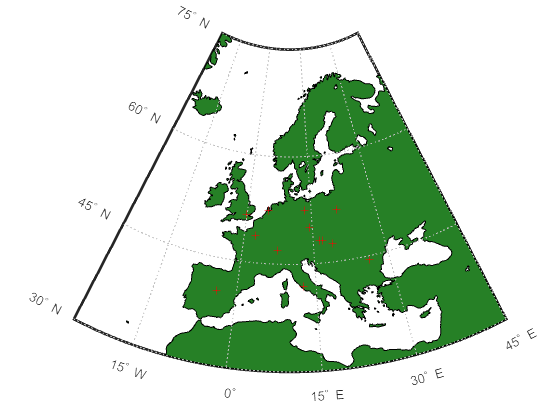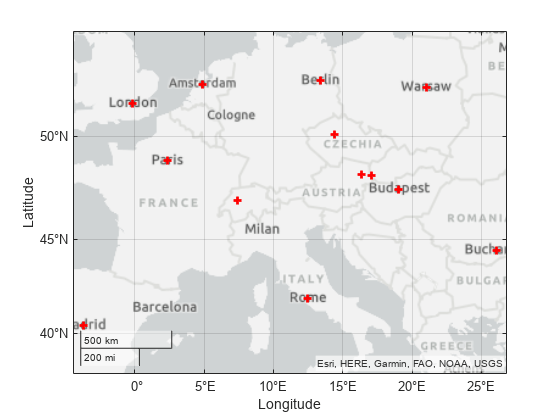geopoint
Geographic point vector
Description
A geopoint vector is a container object that holds geographic point coordinates and attributes. The points are coupled, such that the size of the latitude and longitude coordinate arrays are always equal and match the size of any dynamically added attribute arrays. Each entry of a coordinate pair and associated attributes, if any, represents a discrete element in the geopoint vector.
To create a geographic point shape for use with a geospatial table, create a geopointshape
object instead.
Creation
Syntax
Description
p = geopoint() constructs an empty geopoint vector with
these default property
settings:
p =
0x1 geopoint vector with properties:
Collection properties:
Geometry: 'point'
Metadata: [1x1 struct]
Feature properties:
Latitude: []
Longitude: []p = geopoint(
sets the latitude,longitude)Latitude and Longitude
properties of geopoint vector p
p = geopoint(
sets the latitude,longitude,Name,Value)Latitude and Longitude
properties, then adds dynamic properties to the geopoint vector using
Name,Value argument pairs. You can specify several
name-value pair arguments in any order as
Name1,Value1,...,NameN,ValueN.
p = geopoint( constructs
a new structArray)geopoint vector from the fields of the structure,
structArray.
If
structArraycontains the fieldLat, and does not contain a fieldLatitude, then theLatvalues are assigned to theLatitudeproperty. Similar behavior occurs whenstructArraycontains the fieldLon, and does not contain the fieldLongitude.If
structArraycontains bothLatandLatitudefields, then both field values are assigned top. Similar behavior occurs forLonandLongitudefields when both are present instructArrayOther fields of
structArrayare assigned topand become dynamic properties. Field values instructArraythat are not numeric data types, string scalars, string arrays, character vectors, or cell arrays of numeric data types or character vectors are ignored.
p = geopoint(
sets the latitude,longitude,structArray)Latitude and Longitude
properties, and sets dynamic properties from the field values of the structure,
structArray.
If
structArraycontains the fieldsLat,Latitude,Lon, orLongitude, then those field values are ignored.
Properties
Object Functions
append | Append features to geographic or planar vector |
cat | Concatenate geographic or planar vector |
disp | Display geographic or planar vector |
fieldnames | Return dynamic property names of geographic or planar vector |
isempty | Determine if geographic or planar vector is empty |
isfield | Determine if dynamic property exists in geographic or planar vector |
isprop | Determine if property exists in geographic or planar vector |
length | Return number of elements in geographic or planar vector |
properties | Return property names of geographic or planar vector |
rmfield | Remove dynamic property from geographic or planar vector |
rmprop | Remove property from geographic or planar vector |
size | Return size of geographic or planar vector |
struct | Convert geographic or planar vector to scalar structure |
vertcat | Vertically concatenate geographic or planar vectors |
Examples
More About
Tips
If
Latitude,Longitude, or a dynamic property is set with more values than features in the geopoint vector, then all other properties expand in size using 0 for numeric values and an empty character vector ('') for cell values. See Manipulate a Geopoint Vector for examples of these behaviors.If a dynamic property is set with fewer values than the number of features, then this dynamic property expands to match the size of the other properties by inserting a 0, if the value is numeric, or an empty character vector (
''), if the value is a cell array.If the
LatitudeorLongitudeproperty of the geopoint vector is set with fewer values than contained in the object, then all other properties shrink in size.If either
LatitudeorLongitudeare set to [ ], then both coordinate properties are set to [ ] and all dynamic properties are removed.If a dynamic property is set to [ ], then it is removed from the object.
Version History
Introduced in R2012a


